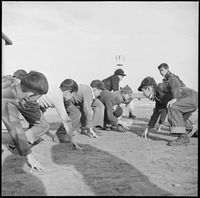Well, yeah! No ... hell yeah!
What is so amazing about this little headline, which ran in the Wall Street Journal on March 11, 2013, is that it's considered news.
Cross training is not all that much different from what we did in elementary P.E. back in the '40s in Southern California. No, we didn't have dumbbells and other fancy equipment, but we ran sprints, distances, did sit-ups, push-ups, pull-ups, climbed ropes, and did various other calisthenic combinations right out of our P.E. teachers’ military-fitness training manual.
We also walked to school, biked, played organized sports after school and on weekends in vacant lots. We walked everywhere because gasoline was rationed during World War II (and besides, our parents told us that's why God gave us legs and parents gave bikes and roller skates for birthdays and Christmas).
We don't need some committee from the American College of Sports Medicine telling us it’s okay for kids to "cross train"

Japanese-American boys playing touch football on a sandlot at a relocation camp in Colorado in 1942. (Dept. of the Interior photo by Tom Parker)
Summers were even more vigorous. We made our own skateboards, ran to the beach, and body surfed. When the surf was up, we lugged a 70-pound redwood surfboard a quarter mile to the beach and back. While we were there, we were in the water most the day. If not board surfing, it was skim boards, body surfing, beach volleyball and, on occasion, touch football. When I went inland to visit my cousins, we walked everywhere and pogo sticks were a rage. So were parks and recreation where we played until dinner and went back until they turned off the lights. Some part of nearly every day was spent at the municipal pool, flying kites, shooting hoops—almost always outdoors.
In the winter, when the water was cold and choppy, there wasn't a vacant lot in town that didn't have some organized activity going on. And all that was before a new indoor community recreation center opened up. The main ingredient that made things work was a dedicated recreation director with a whistle whose number one skills were settling disputes and putting band aids on scraps. And on weekends, the recreation supervisor was joined by a group of parent volunteers who, well ... just watched and occasionally got into the games themselves.
Here's my point: Good for Cross Fit cross-training. I'm sure it works well for those who have parents with sufficient resources to pay for it. And, we don't need some committee from the American College of Sports Medicine telling us it’s okay. for kids to "cross train." Homo sapiens have been doing some version of cross training since God invented us. It's only recently—say the past couple of decades—that kids participating in vigorous exercise has become news.
We had a blip of hope in the '50s when President John F. Kennedy listened to one of his personal physicians, Dr. Hans Kraus. Kraus who Da Coach worked with personally, told Kennedy if something wasn't done soon, American kids would be the least fit in the world. And this low level of fitness would eventually manifest itself in chronic conditions such as heart and vascular disorders and various orthopedic conditions. Kraus called them Hypokenitic Disease, which simply means diseases that are directly attributable to inactivity.
For well over 50 years, we have known that an increasing percentage of kids among all advanced industrial nations are showing a remarkable collection of chronic disease symptoms by the time they get to junior high school. Obese, inactive, low motor skills, hypertensive, and a strong tendency to focus their time and attention on hypokenetic activity (obsessive TV, computer games, texting, tweeting and other digital activities). As their physical capacity degenerates, they become even less and less inclined to choose physical activity and exercise as a leisure pursuit. Sitting all day has become "normal."
When obesity, a symptom, is combined with hypokinetic behavior (gross levels of sitting for extended periods on a daily basis), there is loss in bone density, an increase in muscle atrophy, reduction in stroke volume of the heart, hypertension, reduction in hand-eye coordination, agility, increase percent body fat and a reduction in well-being. Therefore, many kids today experience early onset of muscle fatigue, making it uncomfortable to do what kids from earlier generations did all day while calling it "fun and play."
Da Coach is going into these details to remind educators, health experts and today's concerned parents what has been known for several decades. Today's environment and the introduction of the digital age is incompatible with healthy living, and becomes more so with each decade. Today, survival of the fittest is a fact of life. Those parents who ignore this fundamental physiological principle pay the price. So will their offspring.
Because we no longer require quality, daily physical education in the nation's public schools, young adults who elect to take personal responsibility are faced with a variety of "new" exercise choices. Cross training is one of them, and it's good when taught well and done regularly. But it is not a get-fit-quick formula. My point is far too many people jump from one exercise platform to another, always experimenting but never committing. And in many cases, they go in with far too high an expectation based upon the advertising claims. When they find that this program also includes sweat, fatigue, and may cause some muscle soreness and discomfort, they stop until the next system is "invented.” Of course it’s often just a repackaging of the tired-and-true.
Parents, if you love your kids and want them to be successful and well-adjusted adults, then in addition to reading, writing and arithmetic, demand quality daily P.E. for at least 45 minutes or so. That's in addition to recess and after-school play, with special attention given to all underdeveloped and obese youngsters.
If someone offers a cross-training program, that's cool too. And if you want your kids to be healthy and fit remember that regardless of what it's called, the greatest fitness motivator for your kids will be watching you do it.
Da Coach
